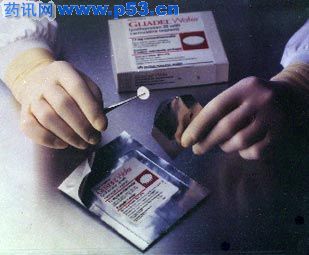|
卡莫司汀对脑肿瘤的抑制作用明显,然而全身应用毒副作用较大.将卡莫司汀它制成植入缓释剂不仅可以更好的发挥其肿瘤抑制作用,而且可以减小其毒副作用.美国Guilford公司研制了以聚苯丙生为载体的卡莫司汀缓释植入剂Gliadel,脑瘤手术时植入,对脑瘤有较好的效果.
PLGA也是生物相容性、体内可降解的缓释生物材料.与聚苯丙生相比,PLGA的稳定性更好,力学性能更好,安全性更高,生物降解性好.PLGA稳定性好,且已被美国FDA批准可用于缓释药物载体和其他人体植入的装置.本试验中以PLGA为缓释载体制作的卡莫司汀缓释植入剂在体内外释放稳定,释放特性符合实验设计的要求,释放周期约为一个月(数据待发表).
我们使用蓝金公司研制的以PLGA为载体的卡莫司汀缓释植入剂,对脑瘤以外的S180肿瘤进行了研究,以检验其治疗效果.结果表明BCNU15、BCNU25组和瘤内注射组均能很好的抑制$180荷瘤小鼠肿瘤生长(〈0.05).BCNU159/6组能有效的延长小鼠的生存时间.
临床上卡莫司汀一个疗程的全身给药量是300-600mg/人,即5-10mg/kg,折合每只小鼠用量为0.125—0.25mg.BCNU159/6组卡莫司汀缓释植入剂含卡莫司汀量是3.75mg.卡莫司汀缓释植入剂所含的3.75mg的卡莫司汀几乎全部集中在植入部位,到达全身的药量非常少,所以小鼠全身几乎没有显出毒副作用,一个月后小鼠能正常生长且生长良好,在6O天的观察期内,有7O9/6的小鼠存活.BCNU259/6组含卡莫司汀6.25mg,虽然显示出了很好的肿瘤抑制作用,但由于所含药物量太大,全身毒性过大,导致小鼠而死.与BCNU159/6含量相同的瘤内注射组尽管分两次给药,但仍然显出了极大的毒副作用,比大剂量的卡莫司汀缓释植入剂25组的毒副作用明显增强.
本试验结果表明,以PLGA为载体的卡莫司汀缓释植入剂能显著降低BCNU的毒副作用,提高疗效,抑制S180肿瘤生长,延长小鼠的生存时间.主要是因为卡莫司汀缓释植入剂在小鼠体内有较理想的缓释速度与缓释时间(结果待发表).因此,卡莫司汀缓释植入剂不仅可以达到好的治疗效果,还可以使除局部用药部位外的其它组织与器官不受伤害.选用适当的高分子载体,合适的药物和载药量可有效调节药物释放速度与释放时间,可使常用抗癌药物发挥更好的效果.
总之,本文的试验数据表明,以PLGA为载体的卡莫司汀缓释植入剂毒副作用显著小于注射剂,疗效显著提高;通过实验数据和文献比较,卡莫司汀一PIGA缓释植入剂疗效优于卡莫司汀一聚苯丙生缓释植入剂,PLGA是作为卡莫司汀缓释载体的一种较佳的选择;本文数据不仅为卡莫司汀一PLGA缓释植入剂临床应用提供了参考,同时验证了卡莫司汀缓释植入剂应用于脑外肿瘤治疗的可能性.本研究由山东蓝金生物工程有限公司和曲阜师范大学博士启动基金(2OO5)资助.
Guilford制药公司日前宣布,FDA批准其治疗脑癌的专利药:以聚苯丙生20为载体的卡莫司汀植入膜剂(polifeprosan 20 with carmustine implant,Gliadel)为罕用药,在治疗接受一期切除术的恶性胶质瘤患者领域享有7年的市场独占期。按照罕用药法案(Orphan Drug Act)规定,该独占期始于获得批准的日期即2003年2月,终止于2010年2月。
本品为一种白色至灰白色的一角硬币大小的薄膜,包含生物可降解聚合物聚苯丙生20和7.7mg卡莫司汀(carmustine,BCNU),卡莫司汀是治疗恶性胶质瘤的常用静脉给药的化疗药物。当手术切除脑瘤时,在经手术创建的空腔中可最多植入8片本品。在植入处,本品将缓慢溶解,直接向肿瘤部位释放高浓度卡莫司汀,使扩撒到其它部位的药物减至最少。
本品适应证是新诊断为高度恶性胶质瘤的患者的手术和放疗辅助药物,也可作为多形性胶质母细胞瘤(GBM)复发患者的手术辅助用药。

| Welcome Patients and Caregivers |
|
Being diagnosed with a brain tumor can be scary and confusing. You have a lot to absorb and try to understand. Know that you don’t have to go through this alone. GLIADEL.com is here to help you and your loved ones understand brain tumors and the GLIADEL® Wafer, a treatment for newly diagnosed high-grade malignant gliomas as an adjunct to surgery and radiation and recurrent glioblastoma multiforme as an adjunct to surgery. GLIADEL is a biopolymer wafer designed to deliver carmustine (a chemotherapy drug) directly into the surgical cavity created when a brain tumor is resected. GLIADEL slowly dissolves and delivers carmustine.
At GLIADEL.com you’ll also find resources to help you manage your condition, techniques for coping with stress , and much more. Get started now by learning more about brain tumors. |
Important Safety Information
GLIADEL Wafer should not be given to patients who have demonstrated a previous hypersensitivity to carmustine or any of the components of GLIADEL Wafer.
Patients undergoing craniotomy for malignant glioma and implantation of GLIADEL Wafer should be monitored closely for known complications of craniotomy, including seizures, intracranial infections, abnormal wound healing, and brain edema. Cases of intracerebral mass effect unresponsive to corticosteroids have been described in patients treated with GLIADEL Wafer, including 1 case leading to brain herniation.
Carmustine, the active component of GLIADELWafer, can cause fetal harm when administered to a pregnant woman. It is recommended that patients receiving GLIADEL Wafer discontinue nursing.
Communication between the surgical resection cavity and the ventricular system should be avoided to prevent the wafers from migrating into the ventricular system and causing obstructivehydrocephalus. If a communication larger than the diameter of a wafer exists, it should be closed prior to wafer implantation.
CT and MRI of the head may demonstrate enhancement in the brain tissue surrounding the resection cavity after implantation of GLIADEL Wafer. This enhancement may represent edema and inflammation caused by GLIADEL Wafer or tumor progression.
The short-term and long-term toxicity profiles of GLIADEL Wafer when given in conjunction with chemotherapy have not been fully explored.
The following 4 categories of adverse events are possibly related to treatment with GLIADEL Wafer:
Seizures: In the initial surgery trial, the incidence of seizures was 33.3% in patients receiving GLIADEL Wafer and 37.5% in patients receiving placebo. Grand mal seizures occurred in 5% of GLIADEL Wafer–treated patients and 4.2% of placebo-treated patients. The incidence of seizures within the first 5 days after wafer implantation was 2.5% in the GLIADEL Wafer group and 4.2% in the placebo group.
In the surgery for recurrent disease trial, the incidence of post-operative seizures was 19% in both patients receiving GLIADEL Wafer and placebo. In this study, 12/22 (54%) of patients treated with GLIADEL Wafer and 2/22 (9%) of placebo patients experienced the first new or worsened seizure within the first 5 post-operative days.
The median time to onset of the first new or worsened post-operative seizure was 3.5 days in patients treated with GLIADEL Wafer and 61 days in placebo patients.
Brain Edema: In the initial surgery trial, brain edema was noted in 22.5% of patients treated with GLIADEL Wafer and 19.2% of patients treated with placebo. Development of brain edema with mass effect (due to tumor recurrences, intracranial infection, or necrosis) may necessitate re-operation and, in some cases, removal of GLIADEL Wafer or its remnants.
Healing Abnormalities: The following healing abnormalities have been reported in GLIADEL Wafer clinical trials: wound dehiscence, delayed wound healing, subdural, subgaleal or wound effusions, and cerebrospinal fluid leak. In the initial surgery trial, healing abnormalities occurred in 15.8% of GLIADEL Wafer–treated patients and in 11.7% of placebo recipients. Cerebrospinal fluid leaks occurred in 5% of GLIADEL Wafer recipients and 0.8% of those given placebo.
During surgery, a water-tight dural closure should be obtained to minimize the risk of cerebrospinal fluid leak. In the surgery for recurrent disease trial, the incidence of healing abnormalities was 14% in GLIADEL Wafer–treated patients and 5% in patients receiving placebo wafers.
Intracranial Infection: In the initial surgery trial, the incidence of brain abscess or meningitis was 5% in patients treated with GLIADEL Wafer and 6% in patients receiving placebo. In the recurrent setting, the incidence of brain abscess or meningitis was 4% in GLIADEL Wafer patients and 1% in patients receiving placebo.
Please see full Prescribing Information.
This Web site contains information relating to various medical conditions and their treatment. Such information is provided for educational purposes only and is not meant to substitute the advice of a physician or other health care professional.
You should not use this information for diagnosing a health problem or disease. Only your doctor can assess the benefits and risks of therapy to determine whether a medication is right for you. You should discuss any questions about you or your loved one’s personal medical needs with your doctor.
The laws, regulatory requirements and medical practices for pharmaceutical products vary from country to country.
The information provided in this Web site is intended for residents of the United States only. The products discussed herein may have different product labeling in different countries.
| 
